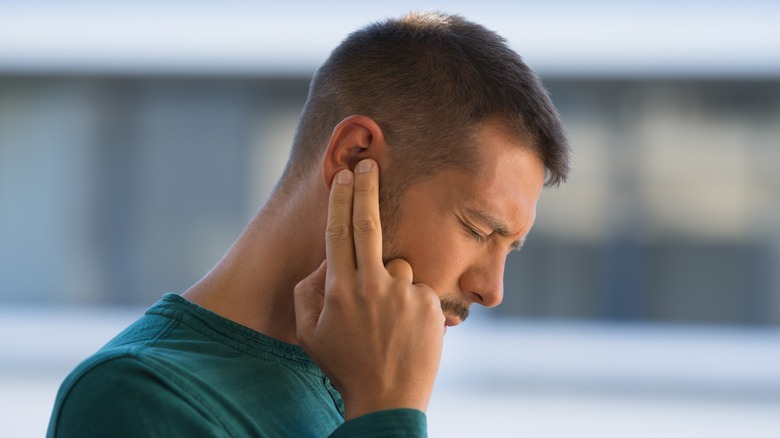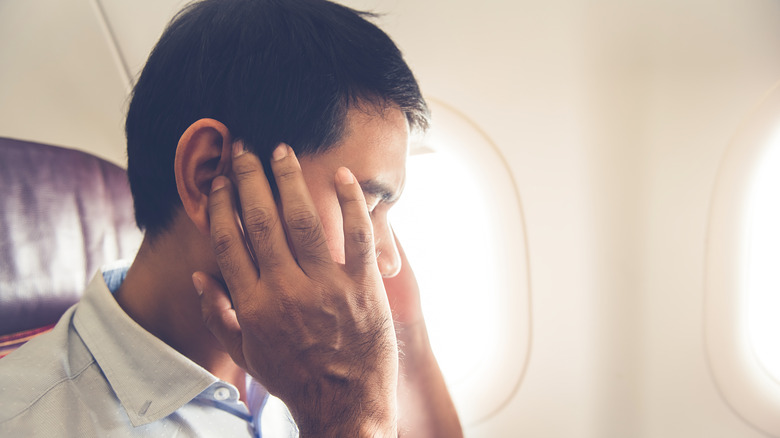How To Relieve Ear Congestion
From time to time most have experienced congested ears, a feeling of fullness in the ears, or a sense that the ear is clogged up. This sensation can be triggered by everything from colds to sinus problems, allergies, and even changes in altitude (via Healthline). According to Medical News Today, it can also be caused by allergies, an ear infection, or even impacted earwax.
Ear congestion occurs as a result of the eustachian tubes, which run between the middle ear and the back of the nose, being blocked (via the Mayo Clinic). The eustachian tubes swell up from a cold or infection, which can lead to blockage. When you have this blockage you may experience a feeling of fullness or pressure in your ears. You may also have ear pain, dizziness, and muffled hearing. As the swelling begins to ease, the blockage tends to resolve.
Given that ear congestion has so many possible causes, as well as a host of unpleasant symptoms, it may be hard to know upfront how best to relieve the symptoms. However, there are a number of techniques you can try to help ease your inner ear discomfort.
Sometimes simple solutions work best
When you are feeling congested there are some simple things you can do to try and relieve the pressure. Swallowing, yawning, or chewing gum will help to open the eustachian tubes and allow airflow into and out of the middle ear (via MedlinePlus). You can also try home remedies, such as a saline spray, or holding a warm, damp towel to your face (via WebMD).
Experts have also found the Valsalva maneuver to be helpful in reducing ear pressure, according to Mercy Health. For the Valsalva maneuver, close your mouth, pinch your nose shut, and try to force the air out through your nose. This maneuver can clear the eustachian tube by forcing air through the sinuses and the tube. It can also be used to restore heart rhythm during a tachycardia event. However, you shouldn't attempt it if you have high blood pressure or are at risk for a stroke or heart attack.
If you don't find the Valsalva maneuver to work for you, you can also try the Toynbee maneuver (via Healthline). This involves pinching your nose closed while swallowing at the same time. However, a 2017 study published in Otology & Neurology suggested that this particular maneuver may not produce the same effects as the Valsalva maneuver.
Reach for the medicine cabinet if you have to
You can opt to try over-the-counter medications, like acetaminophen or ibuprofen, to relieve ear congestion symptoms (via WebMD). You can also use a nasal decongestant spray. However, you should not use one for more than three days, as the more you use, the more you will continue to need. You should also stay hydrated, which will help keep nasal mucus thin.
In some severe cases ear tubes, also called tympanostomy tubes, ventilation tubes, myringotomy tubes, or pressure equalization tubes, are needed to drain fluid and relieve pressure (via the Mayo Clinic). Ear tubes, typically described as hollow cylinders, are surgically inserted into the eardrum and enable drainage of the middle ear and allow air to flow preventing the buildup of fluid behind the eardrum. Although ear tubes are commonly associated with children suffering from ear infections, according to Cleveland Clinic, they can be used to treat adults who suffer from barotrauma, an ear condition brought on by changes in air pressure. However, with any ear condition, it's always advisable to speak with your doctor before undertaking any treatment to make sure that whatever is clogging up your ear canal is treated correctly.



